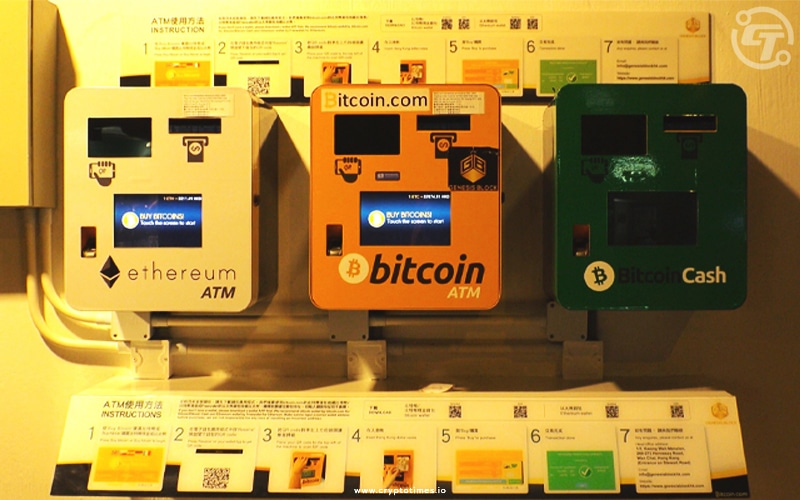Money has always been a tangible concept. You could hold it, fold it, and stash it in your wallet. But picture this: You walk up to a sleek, futuristic machine, insert some cash, and moments later, you hold digital gold in your hands.
Welcome to the world of cryptocurrency ATMs, where financial engagement and the very essence of money are undergoing a transformation. As digital assets gain prominence in the financial landscape, the demand for convenient and accessible ways to buy and sell them has increased significantly. This demand has led to the proliferation of cryptocurrency ATMs (Automated Teller Machines), which are playing a pivotal role in revolutionizing the way people interact with cryptocurrencies.
The rapid growth paints a positive picture, as mentioned in a report highlighting that the global crypto ATM market is projected to reach $472.18 million by 2027, growing at a compound annual growth rate (CAGR) of 59.01%. Since it is expected to expand its scope in the coming years, it becomes important to develop a better understanding of crypto ATMs and what they have in store!
The Genesis of Cryptocurrency ATMs
The concept of cryptocurrency ATMs can be traced back to the early days of Bitcoin. Satoshi Nakamoto’s whitepaper, published in 2008, introduced the world to the revolutionary idea of a decentralized digital currency. In the subsequent years, Bitcoin gained a loyal following, and the need for an infrastructure that allowed users to buy and sell Bitcoin with ease became evident.
The first Bitcoin ATM was introduced in Vancouver, Canada, in 2013 by a company named Bitcoiniacs and Robocoin. This pioneering machine marked a significant milestone in the cryptocurrency journey, as it provided a physical location where people could exchange their fiat currency for Bitcoin and vice versa.
This innovative approach to cryptocurrency transactions sparked a wave of interest and investment in the sector.
How Cryptocurrency ATMs Work
Cryptocurrency ATMs function in a manner similar to traditional bank ATMs but, of course, with a cryptocurrency twist.
Here’s a step-by-step breakdown of how they operate:
1. User Verification
To begin a transaction at a cryptocurrency ATM, users often need to complete a one-time verification process. This may involve providing personal identification information (KYC – Know Your Customer) or simply scanning their government-issued ID.
2. Wallet Selection
Users must have a cryptocurrency wallet to receive the purchased digital assets. They can choose to use an existing wallet or create a new one using the ATM’s interface.
3. Transaction Type
Users choose if they want to buy or sell cryptocurrency. For example, if they buy, they specify the amount of fiat currency they wish to exchange for digital assets. If selling, they can choose the amount of cryptocurrency they want to sell.
4. Payment and Confirmation
To buy cryptocurrencies, users can insert cash into the ATM, use their credit or debit card, or even transfer funds electronically. The ATM calculates the equivalent cryptocurrency amount based on the current exchange rate and user preferences. After confirming the transaction, the cryptocurrency is sent to the user’s designated wallet.
5. Receipt and Confirmation
Users typically receive a transaction receipt as proof of their purchase or sale. This receipt includes essential details, such as the transaction ID and wallet address.
Benefits of Cryptocurrency ATMs
Cryptocurrency ATMs offer several advantages that have contributed to their growing popularity:
1. Accessibility
Cryptocurrency ATMs are strategically placed in various locations, making it easy for people to access digital assets without the need for online exchanges or intermediaries. Reportedly, Australia has installed more Bitcoin ATMs than the entire Asia continent, ranking third behind its top contenders, namely Canada and the US.
2. Speed and Convenience
These ATMs enable swift transactions, allowing users to buy or sell cryptocurrencies quickly and conveniently, especially in areas where online access may be limited. Also, individuals traveling to a foreign country can avoid the hassle of going to a currency exchange to convert their digital assets when they can simply use a crypto ATM.
3. Financial Inclusion
Cryptocurrency ATMs help bridge the gap for individuals who may not have access to traditional banking services but can use cash to enter the world of digital currencies.
4. Anonymity
While some machines require user verification, many cryptocurrency ATMs offer a degree of anonymity, appealing to individuals who value privacy in their financial transactions.
Challenges and Considerations
While cryptocurrency ATMs offer numerous benefits, they are not without challenges and considerations.
1. Regulatory Hurdles
The regulatory environment surrounding cryptocurrency ATMs varies by country and can change rapidly. Some regions have embraced these machines, while others have imposed strict regulations or even bans.
2. Security Risks
Just like traditional ATMs, cryptocurrency ATMs are susceptible to security risks. The anonymity that crypto ATMs offer makes them susceptible to scams and fraud. The same reason makes it difficult to track down scammers and recover funds in case of any mishap. Most recently, a woman lost $6,600 in a new Bitcoin ATM scam.
Hence, the success of crypto ATMs relies on how regulators address the challenges and how the industry evolves in terms of security and convenience.
3. Transaction Fees
Using cryptocurrency ATMs often involves fees, which can include transaction fees, exchange rate fees, and operator fees. These fees can range from 5 to 20 percent, which is inconvenient since crypto exchanges charge as little as 1 percent. As such, these fees can vary widely, and users should be aware of the cost associated with each transaction.
4. Limited Cryptocurrency Selection
Not all cryptocurrency ATMs support a wide range of cryptocurrencies. Users may find that their preferred digital assets are not available at certain machines.
Crypto ATMs in India
The introduction of Bitcoin ATMs in India began with the installation of the first machine in Bengaluru back in 2018.
This initiative was carried out by Unocoin, an Indian blockchain solutions company. Unfortunately, shortly after its installation, the government seized the Bitcoin ATM due to regulatory restrictions imposed by the Reserve Bank of India (RBI).
This Bitcoin ATM was never reopened to the public. Although the RBI eventually lifted its ban on cryptocurrencies, several regulations remained in place, which continued to limit the proliferation of Bitcoin ATMs in the country.
Currently, there is information about the existence of a Bitcoin ATM in Delhi, but its operational status remains uncertain. Not only India, but many countries have clamped down on crypto ATMs, and others have restricted access for fear of crypto scammers running the gamut of fraud.
Recently, the UK’s FCA halted the operations of 26 crypto ATMs, while a Bitcoin ATM provider Bitcoin of America ceased its operation due to the absence of proper licensing.
On the other hand, if you are considering using Bitcoin ATM in India, it is essential to be aware of a few crucial points mentioned below:
- Transactions conducted via Bitcoin ATMs are irreversible, meaning that once executed, they cannot be reversed or refunded.
- Keep in mind that Bitcoin obtained through these ATMs cannot be used for paying services or bills in most cases; it’s primarily for investment or trading purposes.
- If you possess a paper wallet for your Bitcoin transactions, it is of utmost importance to safeguard it diligently and refrain from sharing its details, including any images of it, with anyone, even trusted individuals.
- Always acquire Bitcoin for your personal use and investment, avoiding any involvement in transactions on behalf of third parties to mitigate potential risks and complications.
The Future of Cryptocurrency ATMs
As the adoption of cryptocurrencies continues to grow, cryptocurrency ATMs are likely to become even more prominent. Their role in providing easy access to digital assets, especially for crypto enthusiasts, represents a significant development in the world of finance.
While challenges persist, the potential for cryptocurrency ATMs to shape the future of finance and provide financial inclusion to millions cannot be underestimated. Whether you’re a seasoned crypto enthusiast or just curious about this emerging technology, cryptocurrency ATMs are a tangible and accessible gateway into the world of digital assets.
With the growing network of cryptocurrency ATMs, it’s clear that the future of finance is increasingly decentralized and inclusive. However, always consider the fees these ATMs charge, which can be high in some cases. At the same time, gauge the risks and security challenges associated with them.







